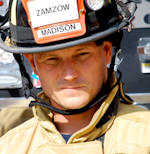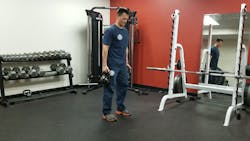Health & Wellness: 5 Exercises Every Firefighter Needs to Do
I have had the privilege to write for Firehouse for the last four years. We have published a few list-type articles, like the most underrated exercises, the best bodyweight exercises and the best back exercises. These lists are always the source of great conversations when I present at conferences and visit departments. Usually the conversation centers on the one list that we’ll tackle today: the five exercises that every firefighter needs to do. While you’ll probably get different answers from different trainers, these are the five that I strongly believe every firefighter needs to include in their workout.
1. Deadlifts
I tried to get a little creative and list some different exercise variations, but the deadlift is the one “granddaddy of exercises” that almost every trainer recommends. Not only is it a great exercise in general, it’s one that every firefighter or firefighter-in-training should learn to do. The deadlift can be an intimidating exercise, so many firefighters tend to skip it or substitute the leg press. If you break down the mechanics and motion of the deadlift, it’s easy to see how applicable it is to our job, as we essentially perform deadlifts many times per shift without even realizing it—grabbing a cot, lifting hose, carrying saws and tools, etc. Deadlifts are a part of our job, so incorporating them into your exercise program only makes sense.
How to do it: Nothing is more natural to the human body than the task of lifting something from the ground. The principal idea of the deadlift is very simple: Pick up a barbell or dumbbells off the ground and set it or them back down. Make sure to keep your feet flat on the ground and maintain good posture throughout the movement. Brace your abs for added back protection.
2. Front-to-Side Planks
It’s no surprise that one of the exercises on this list is a core exercise. Back injuries are the number one reason firefighters, EMTs and medics go on early disability, so it's imperative that we, as fire-rescue athletes, focus on strengthening core muscles. The front-to-side plank exercise requires no equipment and is incredible for improving core strength, endurance and balance. This is a unique exercise because it targets the obliques and deep muscles of the glutes. This is especially important because most back injuries in firefighters are a result of some type of twisting motion. Strengthening the obliques and glutes can help control movement through the transverse plane and reduce the likelihood of injury.
How to do it: With the front plank, set yourself up so your forearms and feet are on the floor, and your elbows are directly below your shoulders. Your body should form a straight line from your head to your feet. Hold the position for a set amount of time, and then rotate to one side. Using your lower elbow and forearm, prop your body up, making sure to keep your abs tight the entire time. Your body should form a straight line from shoulders to ankles. Squeeze your abs and glutes to keep your body stabilized. As for foot position, rather than stacking the feet one on top of another, I like to bring the foot of my upper leg so it is resting slightly ahead of the foot of the lower leg. This makes it much easier to keep your hips and ribs stacked. Try to hold each position for 10 to 30 seconds.
3. Step-ups
The step-up is a compound exercise that works several lower-body muscles that are critical to firefighter performance. It also requires balance and core stabilization and is a good strength exercise since it mimics most of the movements firefighters perform on duty. As a firefighter, you perform the step-up more times than you probably notice. As rigs seem to get bigger and taller, so do the steps to get in them. I have the privilege to work most of my shifts on a ladder truck, and on a recent 24-hour shift, I counted my step-ups just getting in and out of the rig during the shift. It was over 80! Performing this movement correctly is imperative to lower body and back health for any firefighter.
How to do it: Find a platform or box—something that is stable and not going to move out from under you when you step up onto it. With your hands at your sides and feet pointed straight ahead about hip distance apart, simply step up onto the box with your right foot. With your right foot planted firmly on the top of the step, lift your body up onto the platform by tightening your glutes and your abdominal muscles. Keep your back straight and maintain a slow and controlled pace with each movement. After elevating to the top of the step, move the right foot back to the starting position and slowly lower your body back to the starting position. Try to perform 10 to 15 repetitions with the right leg and then repeat with the left.
One of the benefits of the step-up exercise is the number of variations that make the exercise easier or harder with some simple adjustments. Lower the height of the step to make the exercise easier or raise the height to make it harder. You can also make the exercise more challenging (after you master the basic form) by holding a weight or wearing gear/SCBA.
4. Floor-to-Ceiling Press
Carries, hoists, drags and lifts are all very common and essential firefighter motions. All these movements or tasks require good core and upper body strength. I often see firefighters make the mistake of performing lifts in a seated or supported position, yet these positions do not mimic the motions of the fireground. The floor-to-ceiling press requires the body to coordinate the muscles of the legs and transfer it through the core into the upper body. This movement is similar to hoisting a ladder or hoseline. You can perform this exercise with dumbbells, a plate weight, sandbags or even a foam bucket. It is a great exercise to help strengthen the entire body.
How to do it: Stand upright with feet in double hip width position and dumbbells (or plate) in your hands palms facing in. Slowly squat reaching the dumbbells (or plate) toward the ground. Once the weight reaches ankle height, pause and slowly raise them with a curl motion up to your shoulders. Press the dumbbells (or plate) over your head, palms facing in. Be sure to keep your abs tight and glutes squeezed through the entire motion. Maintain a slow and controlled pace.
5. Dynamic Stretching
This is not a single exercise but rather a group of them. I guarantee that active warm-up exercises through dynamic stretching can help you move better, decrease your chance of injury, and ultimately help you look and perform better. Flexibility is often the most overlooked component of an effective firefighter workout program. Don't agree? Just watch anyone go into the firehouse gym or workout room. Most the time you will see firefighters go directly to the strength exercises, maybe with a light warm-up set. Dynamic stretches are very different than performing a warm-up set. Dynamic stretches help “wake up” your muscles and increase flexibility, not just for your workout but for the rest of the day. Just 5 to 10 minutes of dynamic stretching done regularly can improve mobility and performance.
How to do it: Rather than have you hold your stretches, as in traditional static stretching, you move your body into position just for a few seconds and then go back to your starting position. A great example of an active warm-up movement is the Spiderman Stretch. To perform this movement, start in the push-up position, then step forward with your left foot and place it outside of your left hand. Try to drive the hips forward toward the floor and hold that position for 3 to 5 seconds. Do five to six repetitions with each leg. Other dynamic stretches include the full body chop, cross over, inverted hamstring, and side-to-side knees.
Bonus “Exercise”: Good Nutrition
I know nutrition is not an “exercise” per se, but it needs to be addressed in coordination with your workouts. You can do all the exercises you want, but without a solid nutrition plan, you will not see progress. There is a slogan in the fitness business: “You cannot out-train a poor diet.” I have been working with athletes and firefighters for over 20 years and cannot agree more with that statement. So, as a bonus, think about how you fuel your body.
How to do it: Avoid added sugars, eat a lot of vegetables and drink lots of water. These nutrition basics can go a long way to help increase strength and overall health.
Get started!
While others may tout other exercises as being “the best” firefighter exercises, one thing I think we can all agree on is that the exercises must help to improve performance and reduce chances of injury. If performed correctly and consistently, these five exercises will do just that.

Aaron Zamzow
Aaron Zamzow is a firefighter/training officer for Madison, WI, Fire Department. He holds a bachelor’s degree in health/wellness and has 20 years of experience as a fitness trainer. He created Fire Rescue Fitness and authors programs that are aimed at getting fire rescue athletes fit for duty.






